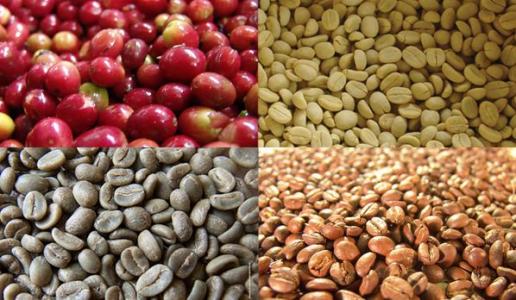A brief introduction to the description of the flavor and aroma characteristics of Costa Rican Saint Roman Coffee

The research center, located about 30 kilometers northeast of San Jose, the capital of Costa Rica, belongs to the Costa Rican Coffee Association and is a national coffee species in Costa Rica.
The newly developed villa sarchi planting, breeding and quality inspection research institutions, in addition, it also has 10 hectares of experimental plots, planting a number of excellent varieties. Coffee is Costa Rica's main agricultural product, with an annual output of more than 2 million bags (60 kg packages) and export earnings of US $250 million, second only to pineapples and bananas. Costa Rica's coffee industry was originally controlled by the Costa Rican Coffee Industry Company (Instituto de Caf é de ICAFE) and has now been taken over by the official Coffee Committee (Oficinale Cafe). Among the exported coffee, those products that are considered to be of substandard quality are colored with blue vegetable dyes and then transferred back to China for sale. Coffee consumed domestically (dyed blue or undyed) accounts for about 10% of total production, and local per capita coffee consumption is twice that of Italy or the United States.
Brazilian coffee fruit, a coffee producer, accounts for 1/3 of the world's coffee consumption and occupies a place in the global coffee market, although Costa Rica faces several times more natural disasters than other regions. but its acreage is enough to make up for it.
There are many kinds of coffee here, but its industrial policy is large and cheap, so there is not much premium coffee, but it is a good choice for blending other coffee. Tarrazu in Costa Rica is one of the major coffee producers in the world. The coffee produced is light and pure in flavor and pleasant in aroma. Costa Rica, with its fertile volcanic soil and good drainage, is the first country in Central America to grow coffee and bananas for commercial value. Coffee and bananas are the country's main exports. Coffee was introduced into Costa Rica from Cuba in 1729. Today, its coffee industry is one of the well-organized industries in the world, with a yield of 1700 kg per hectare. Costa Rica, with a population of only 3.5 million, has 400 million coffee trees, and coffee exports account for 25 per cent of the country's total exports. Costa Rica has also benefited from the Central American Society for Agricultural Research in Tarasu.
The seven provinces are: Alajuela Alajuela (central, north-west of San Jose), Catago Cartago (central, east of San Jose), Guanacaster Guanacaste (north-west), Eredia Heredia (central, north of San Jose), Limon Lim ó n (east, along the Caribbean Sea), Pentarenas Puntarenas (west, along the Pacific Ocean) and San Jose San Jos é (near the capital).
The capital
San Jose (San Jos é), with an area of 4966 square kilometers and a population of 1.42 million. The average temperature of the hottest month (July) is 21 °C and the average temperature of the coldest month (January) is 9 °26 °C. Costa Rica is located in the Central American isthmus, belonging to North America, latitude 10 °north and longitude 84 °west. It is bordered by the Caribbean Sea to the east and the North Pacific Ocean to the west, with a coastline of 1290 km (212km on the east coast and 1016 km on the west coast). Costa Rica borders Nicaragua in the north (309 km long border) and Panama (639 km long border) south-southeast. There are a total of 51100 square kilometers, including 50660 square kilometers of territory and 440 square kilometers of territorial sea, which is slightly smaller than West Virginia in the United States and equivalent to Ireland.
Costa Rica accounts for only 0.03% of the world's land area, but with nearly 4% of the world's species, Costa Rica is one of the countries with the richest biological species in the world. 26% of the land area is a national park or nature reserve, including 11 wetlands, 2 biological reserves and 3 World Natural Heritage sites. The national forest coverage rate is 52%.
Natural resources include iron, manganese, mercury, bauxite, gold and silver, among which the reserves of bauxite, iron and coal reach 150 million tons, 400 million tons and 50 million tons respectively. The recent situation is mainly distributed in the central gold belt area of the northwestern Tilaran Cordillera Mountains. Calcium carbonate is distributed in the northwest and has high taste. The purity of calcium carbonate extracted from limestone can reach 99.5%. Costa Rica attaches great importance to environmental protection and the exploitation of natural resources is strictly restricted.
Oil is completely dependent on imports, mainly from Colombia and other countries, and is monopolized by the National Oil Company (RECOPE), with an average annual import of 3 million tons of crude oil. Since 2012, the national oil company has suspended crude oil refining production due to aging facilities, and all fuel oil has been imported instead. In 2013, Costa Rica imported 19.3 million barrels of oil, with imports of US $2.3 billion, accounting for 5.5 per cent of GDP.
The research center, located about 30 kilometers northeast of San Jose, the capital of Costa Rica, belongs to the Costa Rican Coffee Association and is a national coffee species in Costa Rica.
The newly developed villa sarchi planting, breeding and quality inspection research institutions, in addition, it also has 10 hectares of experimental plots, planting a number of excellent varieties. Coffee is Costa Rica's main agricultural product, with an annual output of more than 2 million bags (60 kilograms) and foreign exchange earnings of 250 million US dollars, second only to pineapples and bananas.
All the coffee trees planted in Costa Rica are Arabica coffee trees. through improvement, the quality of coffee beans is better and more stable. in order to facilitate picking, coffee trees are kept at a height of about 2 meters through continuous pruning. The coffee that people eat is the taste of the seeds in the fruit that are brewed in water. After picking raw coffee beans, it is necessary to remove the peel, pulp, seed film and sun exposure before the seeds (that is, coffee beans) can be roasted. Now part of the process can be replaced by machines, and the speed of coffee production has increased a lot. However, there is no machine to do coffee picking, so you must use manual labor.
Costa Rican Coffee-introduction
Costa Rican coffee has full particles, ideal acidity and unique strong flavor.
Costa Rica's coffee industry, originally controlled by the Costa Rican Coffee Industry Company (ICAFE), has been taken over by the official Coffee Committee (Oficinale Cafe). Among the exported coffee, those products that are considered to be of substandard quality are colored with blue vegetable dyes and then transferred back to China for sale. Coffee consumed domestically (dyed blue or undyed) accounts for about 10% of total production, and local per capita coffee consumption is twice that of Italy or the United States.
Costa Rica is located in the Central American isthmus, belonging to North America, latitude 10 °north, longitude 84 °west. It is bordered by the Caribbean Sea to the east and the North Pacific Ocean to the west, with a coastline of 1290 km (212km on the east coast and 1016 km on the west coast). Costa Rica borders Nicaragua in the north (309 km long border) and Panama (639 km long border) south-southeast. There are a total of 51100 square kilometers, including 50660 square kilometers of territory and 440 square kilometers of territorial sea, which is slightly smaller than West Virginia in the United States, which is equivalent to Ireland's natural resources of iron, manganese, mercury, bauxite, gold, silver and so on. The reserves of bauxite, iron and coal reach 150 million tons, 400 million tons and 50 million tons respectively. The recent situation is mainly distributed in the central gold belt area of the northwestern Tilaran Cordillera Mountains. Calcium carbonate is distributed in the northwest and has high taste. The purity of calcium carbonate extracted from limestone can reach 99.5%. Costa Rica attaches great importance to environmental protection and the development of natural resources is strictly restricted. The Costa Rican government has 21 ministries, namely: Ministry of Foreign Affairs and religious Affairs, Ministry of the President, Ministry of Interior, Police and Public Security; Ministry of Finance, Ministry of Foreign Trade, Ministry of economy, Industry and Commerce; Ministry of Planning and Economic Policy; Ministry of Health; Ministry of Science and Technology; Ministry of decentralization and Local Development; Ministry of Social Welfare and Family; Ministry of Public works and Transport Ministry of Public Education; Ministry of Housing and settlement; Ministry of Environment and Energy; Ministry of Labour and Social Security; Ministry of Culture and Youth; Ministry of Agriculture and Animal Husbandry; Ministry of Justice and Peace; Ministry of Sports; Ministry of Tourism Partido de Liberaci ó n Nacional: ruling party. It was founded in April 1952 and came to power nine times. At present, there are about 630000 party members, belonging to political parties of a social democratic nature. Internally, we advocate improving democracy, increasing investment in public utilities, improving the democratic system, implementing the policy of opening up trade to the outside world, increasing efforts to attract foreign investment, carrying out pluralistic diplomacy, and supporting regional integration. In February 2010, the party's candidate Chinchilla was elected president, achieving his ninth term in office. Party Chairman Bernal Jimenez (Bernal Jim é nez), General Secretary Antonio Calderon Castro (Antonio Calder ó n Castro)
Coffee was introduced into Costa Rica from Cuba in 1729. Today, its coffee industry is one of the well-organized industries in the world, with a yield of 1700 kg per hectare. Costa Rica has only 3.5 million people but 400m coffee trees, and coffee exports account for 25 per cent of the country's total exports. Costa Rica's volcanic soil is very fertile and well drained, especially in the central plateau CentralPlateau, where the soil consists of successive layers of ash and dust. Costa Rica was therefore the first country in Central America to grow coffee and bananas for commercial value. Coffee and bananas are the country's main exports.
Important Notice :
前街咖啡 FrontStreet Coffee has moved to new addredd:
FrontStreet Coffee Address: 315,Donghua East Road,GuangZhou
Tel:020 38364473
- Prev

A brief introduction to the treatment method of grinding degree and baking degree of half-sun red bourbon El Salvador Himalaya coffee
Salvadoran coffee inherits the mild quality of Sino-American coffee, which is soft, slightly sour and has a beautiful sweetness. At the same time, it also has its own characteristics: the aromatic taste is slightly sour and very soft; it is pure and has no miscellaneous flavor, and the taste balance is excellent; the smooth feeling like cream chocolate is impressive; the dense feeling of coffee in the mouth gives the coffee a deep and long taste.
- Next

A brief introduction to the History and Culture of the Origin and Development of Costa Rican Saint Roman Coffee with rich flavor
All the coffee trees planted in Costa Rica are Arabica coffee trees. through improvement, the quality of coffee beans is better and more stable. in order to facilitate picking, coffee trees are kept at a height of about 2 meters through continuous pruning. The coffee that people eat is the taste of the seeds in the fruit that are brewed in water. After picking raw coffee beans, the peel, pulp, seed film and sun exposure must be removed.
Related
- Detailed explanation of Jadeite planting Land in Panamanian Jadeite Manor introduction to the grading system of Jadeite competitive bidding, Red bid, Green bid and Rose Summer
- Story of Coffee planting in Brenka region of Costa Rica Stonehenge Manor anaerobic heavy honey treatment of flavor mouth
- What's on the barrel of Blue Mountain Coffee beans?
- Can American coffee also pull flowers? How to use hot American style to pull out a good-looking pattern?
- Can you make a cold extract with coffee beans? What is the right proportion for cold-extracted coffee formula?
- Indonesian PWN Gold Mandrine Coffee Origin Features Flavor How to Chong? Mandolin coffee is American.
- A brief introduction to the flavor characteristics of Brazilian yellow bourbon coffee beans
- What is the effect of different water quality on the flavor of cold-extracted coffee? What kind of water is best for brewing coffee?
- Why do you think of Rose Summer whenever you mention Panamanian coffee?
- Introduction to the characteristics of authentic blue mountain coffee bean producing areas? What is the CIB Coffee Authority in Jamaica?

